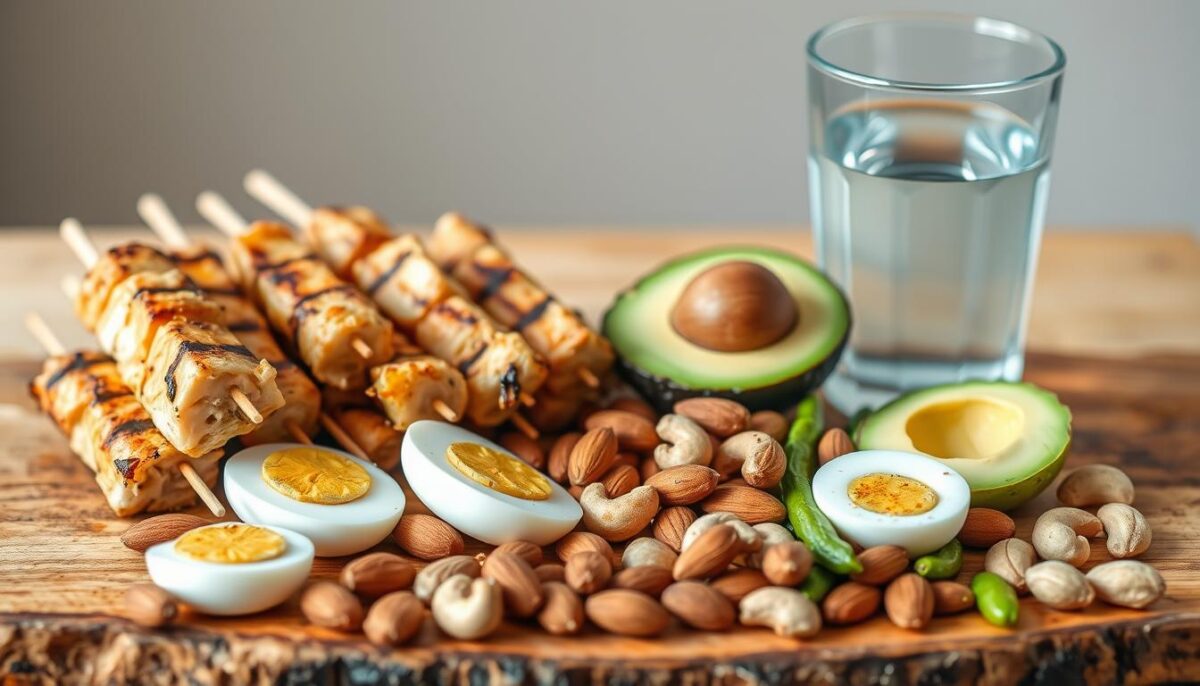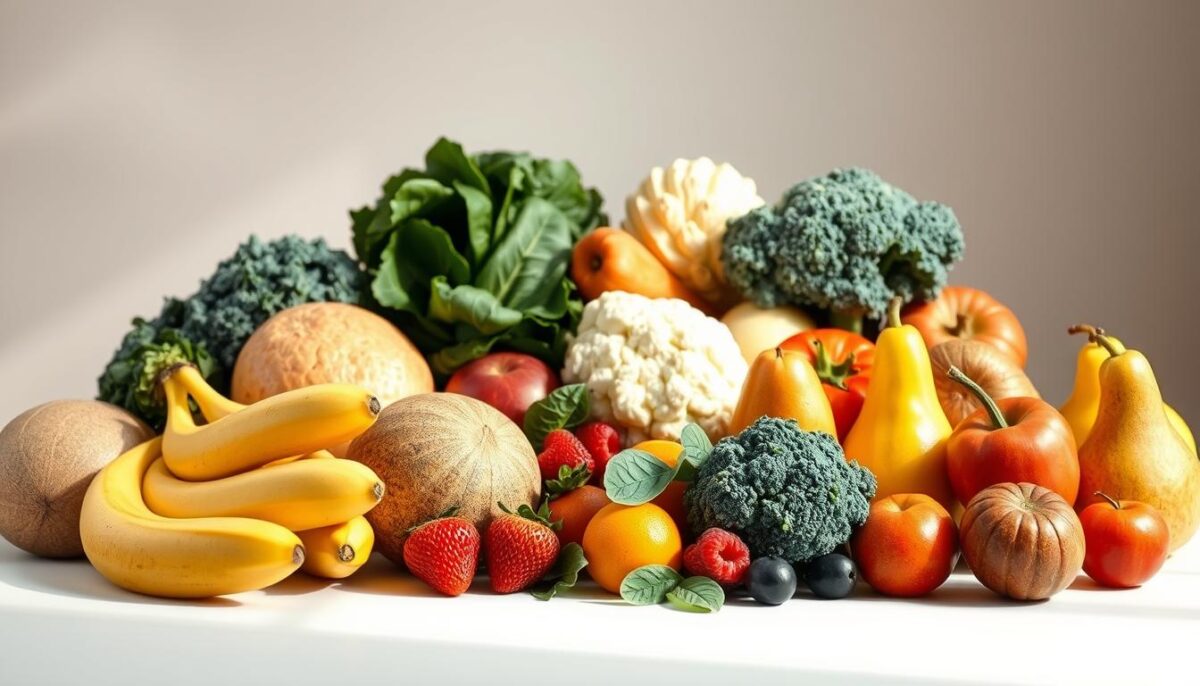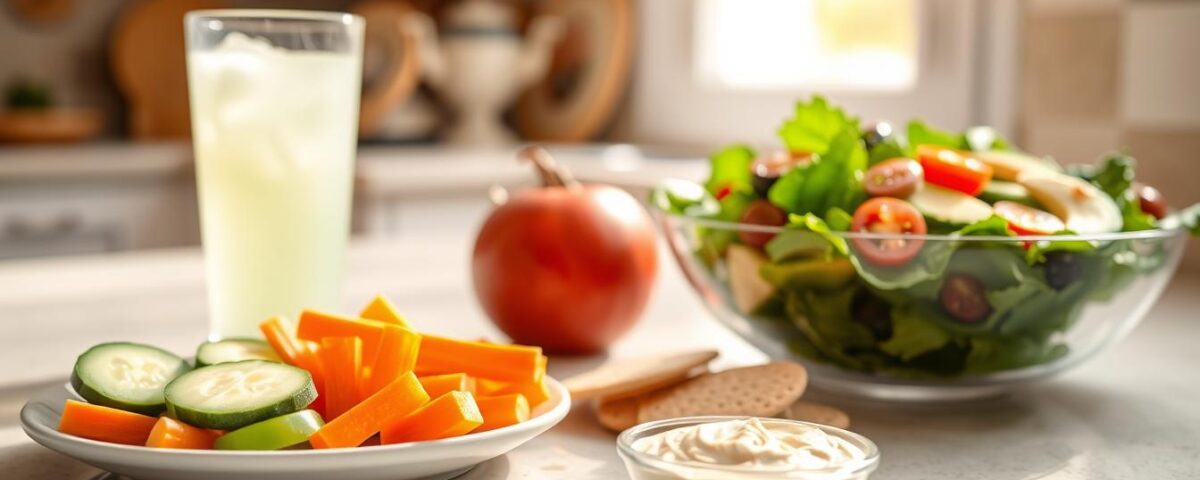
5 Herbal Teas That Calm an Irritated Stomach
May 23, 2025
What You Should Never Eat on an Empty Stomach
May 23, 2025Did you know that over 20% of Americans experience symptoms of GERD (gastroesophageal reflux disease) weekly? For many of us, that burning sensation after eating isn’t just uncomfortable—it can derail an entire day. I’ve been there, staring at snack options and wondering, “Will this leave me regretting it in an hour?”
Living with frequent heartburn taught me that what I eat matters deeply. When stomach acid creeps up, even small choices—like grabbing a handful of almonds instead of chips—can make a world of difference. But finding snacks that are both satisfying and gentle isn’t easy. Trust me, I’ve tried (and failed) more times than I can count.
Through trial, error, and research, I discovered that smart snacking isn’t about deprivation. It’s about balance. Combining the right foods helps me stay energized without triggering that familiar ache. In this guide, I’ll share simple swaps and creative ideas that transformed how I approach my diet—and my day-to-day comfort.
Key Takeaways
- Snack choices directly impact GERD symptoms like heartburn and regurgitation.
- Opt for low-acid, high-fiber options to soothe your stomach.
- Timing matters—small portions spread throughout the day work best.
- Combine protein with non-citrus fruits or veggies for lasting relief.
- Portion control reduces pressure on your digestive system.
- Always prioritize fresh, unprocessed ingredients when possible.
Understanding Acid Reflux and Its Triggers
When I first felt that fiery sensation creeping up my chest, I didn’t realize my favorite latte was the culprit. That’s the sneaky nature of this condition—it often hits when you least expect it.
What Is Acid Reflux?
Imagine stomach contents reversing course like a misdirected elevator. MedlinePlus defines it as “stomach acid repeatedly flowing back into the esophagus”. This backward movement irritates the lining, causing discomfort. For me, it felt like a campfire in my throat after meals.
Common Irritants and Symptoms
Not all discomfort stems from spicy dishes. Through trial and error, I learned even mint tea could spark trouble. Healthline notes these common GERD symptoms:
- A burning feeling that worsens when lying down
- Sour liquid rising into the mouth
- Difficulty swallowing (like food stuck in your chest)
Surprisingly, healthy choices sometimes backfire. A large spinach salad? Perfect—unless you eat the whole bowl in one sitting. Portion control became my secret weapon against flare-ups.
| Common Triggers | Better Alternatives |
|---|---|
| Fried foods | Baked sweet potato fries |
| Coffee | Ginger tea (my go-to) |
| Citrus fruits | Melon cubes |
Speaking of ginger—it’s been a game-changer. Research shows its anti-inflammatory properties can calm the digestive tract. I keep crystallized ginger in my purse for emergencies. Remember, tracking your unique triggers is half the battle won.
Benefits of Smart Snacking for GERD Management
Have you ever noticed how your eating rhythm affects your digestion? I learned the hard way that going hours without food often led to ravenous hunger—and disastrous choices. Dietitians agree: “Frequent, balanced snacks act like pressure valves for your stomach,” as one expert explained during my research. This approach transformed how I fuel my body.

Managing Hunger Throughout the Day
Eating every 3-4 hours keeps extreme hunger at bay. When I snack on almond butter with apple slices mid-morning, I avoid overeating at lunch. Smaller portions spread across the day reduce stomach pressure—a major trigger for discomfort. My nutritionist put it simply: “Fullness shouldn’t feel like a balloon about to pop.”
Balanced Blood Sugar and Portion Control
Steady energy levels mean fewer cravings for sugary fixes. I pair complex carbs like oatmeal with protein-rich Greek yogurt. This combo prevents blood sugar spikes that once left me reaching for chocolate. Now, my main meals feel satisfying without that “I ate a brick” sensation. Bonus? My jeans fit better too.
This strategy didn’t just help manage my symptoms—it gave me back control. No more panicking when meetings run late or dinners get delayed. My body knows nourishment is coming soon, so it stops sounding the acid alarm.
Acid reflux snack ideas
When my doctor first suggested keeping a food journal, I discovered something surprising—my go-to munchies were secretly working against me. Now, my kitchen stays stocked with options that calm rather than provoke.
Quick List of GERD-Friendly Snacks
Through years of testing, these became my safe bets:
| Snack | Why It Works | Prep Tip |
|---|---|---|
| Banana & almond butter | Neutralizes stomach acid | Slice and dip |
| Hard-boiled egg whites | High protein, low fat | Pre-peel for grab-and-go |
| Oatmeal with chia seeds | Soluble fiber protects | Make overnight jars |
| Steamed carrot sticks | Alkaline vegetables | Portion into bags |
I avoid anything that sits heavy. As my nutritionist warned: “Crunchy doesn’t have to mean greasy.” Those baked potato chips? Still a gamble—I stick with rice cakes topped with mashed avocado instead.
Planning is everything. Sundays are for washing grapes and portioning walnuts into tiny containers. This system lets me grab something soothing even during chaotic days. Bonus? My snack drawer now looks like a wellness influencer’s Instagram feed.
Smart Protein-Powered Snack Options
Ever stare at the clock waiting for lunch while your stomach growls? I used to grab whatever was nearby—until I learned how the right protein choices could silence hunger without the burn. Now, my kitchen’s stocked with options that fuel me gently.

Why Lean Proteins Work Better
Chicken breast and egg whites became my heroes. Their low fat content means they digest smoothly, unlike greasy chips or fried meats. A dietitian once told me: “Lean proteins act like sponges—they soak up excess acid instead of provoking it.” Paired with whole-grain crackers or cucumber slices, they keep me full for hours.
My Go-To Protein Snacks
These three combos saved me during afternoon slumps:
| Recipe | Key Ingredients | Why It Works |
|---|---|---|
| Yogurt Parfait | Nonfat Greek yogurt, banana slices | Cooling texture neutralizes irritation |
| Egg White Wrap | Boiled egg whites, spinach, whole wheat tortilla | High protein without heavy fats |
| Cottage Cheese Bowl | Low-fat cottage cheese, diced pear | Combines alkaline fruit with digestive-friendly cheese |
I prep these on Sundays—hard-boiled eggs in the fridge, yogurt cups ready to grab. Baking chicken strips instead of frying them makes all the difference. Bonus? My energy stays steady, and my muscles thank me after workouts.
Fruits and Vegetables That Are Acid Reflux Friendly
Crunching into a crisp apple used to scare me—until I discovered which varieties played nice with my digestion. Finding foods that nourish without causing flare-ups became my mission. Through trial and error, I built a produce arsenal that keeps me satisfied and symptom-free.

Low-Acid Fruits for Relief
Melons became my summer saviors. Watermelon and honeydew’s high water content dilutes stomach irritation. Fuji apples (pH 4.1) became my go-to—their mild sweetness beats tart Granny Smiths any day. I keep pre-sliced cantaloupe in mason jars for quick bites. Dietitian-approved tip: “Pair fruits with a handful of almonds to slow digestion.”
Digestive-Friendly Vegetables
Not all greens are created equal. Romaine lettuce and celery sticks became salad staples—their crunch satisfies without the burn. I roast sweet peppers with olive oil for flavor-packed strips. The fiber in these vegetables acts like a protective barrier, as my nutritionist explained: “It’s nature’s cushion against irritation.”
| Best Choices | Benefits | My Prep Style |
|---|---|---|
| Watermelon | 92% water hydrates esophagus | Cube with mint leaves |
| Fuji apples | Lower acidity than other varieties | Slice with almond butter |
| Celery | Alkaline properties balance pH | Stuff with cream cheese |
Meal prep Sundays now include washing and portioning these vegetables. I’ve learned that the right choice in produce can turn feared foods into allies. Bonus? My grocery cart looks like a rainbow—vibrant, varied, and veto-proof against discomfort.
Snacks to Avoid When You Have Acid Reflux
Navigating snack aisles became a minefield after my diagnosis. What once seemed harmless now carried hidden consequences. Through painful trial and error, I identified patterns in what sparks discomfort.
High-Fat and Acidic Foods
Fried treats were my first lesson. That bag of chips? Turns out their high fat content relaxes the esophageal valve. My nutritionist explained: “Greasy foods linger longer, giving acid more time to rise.” Now I steer clear of these culprits:
| Problematic Choices | Why They Hurt |
|---|---|
| Buttery popcorn | Combines fats with salt |
| French fries | Double whammy of oil and potato starch |
| Cheese dips | Saturated fats slow digestion |
Even “healthy” options betrayed me. Avocado toast? Great—unless you slather on too much butter. Moderation became my mantra.
Triggers You Need to Watch Out For
Some triggers disguise themselves as safe bets. I learned the hard way that:
- Salt-and-vinegar chips irritate the stomach lining
- Mashed potato dishes often hide cream and butter
- Granola bars with “healthy fats” can still contain palm oil
Now I scan labels for hidden fats. My rule? If it leaves grease stains on the bag, it’ll leave fire in my chest. Swapping fried chips for baked root veggie crisps made evenings bearable again.
Remember: Not all healthy fats are equal. While almonds soothe me, cashews sometimes revolt. Listen to your stomach—it speaks louder than any snack craving.
Quick and Easy Snacks for Busy Days
Between back-to-back Zoom calls and school pickups, I’ve mastered the art of fueling my body without stopping. My secret? A collection of grab-and-go options that soothe rather than provoke. These choices keep me moving while respecting my digestive needs.
On-the-Go Snack Ideas
Here’s what lives in my insulated lunch bag during chaotic days:
| Snack | Why It Works | Prep Time |
|---|---|---|
| Rice cakes + almond butter | Neutralizes acid with low-fat protein | 2 minutes |
| Cucumber slices + hummus | Hydrating veggies + fiber-rich spread | 5 minutes |
| Pre-washed grapes + walnuts | Natural sugars + healthy fats | 0 minutes |
I prep these every Sunday. Washed grapes go into snack bags, while single-serve hummus cups stack neatly in the fridge. For mornings when I’m racing out the door, I grab a banana and low-fat string cheese—nature’s perfect portable duo.
Timing matters most during crunch hours. Eating small portions every 3-4 hours prevents that “starving wolf” feeling. My desk drawer holds emergency oatmeal packets for days when meetings bleed into lunch. Just add hot water—no microwave battles required.
Staying prepared means never compromising comfort for convenience. As my nutritionist says: “Smart eating isn’t about having time—it’s about making time.” Now, even my craziest days end without that familiar fiery regret.
Creative Snack Hacks to Enhance Your Diet
What if your kitchen became a lab for crafting delicious, gut-friendly nibbles? After months of experimenting, I discovered that homemade mixes let me control every ingredient—a game-changer for my diet. This approach transformed bland bites into flavorful adventures without the aftermath.
DIY Snack Mixes
My pantry now holds jars of custom blends that satisfy cravings safely. Here’s my go-to list for balanced munching:
| Mix Name | Ingredients | Benefits |
|---|---|---|
| Crunch & Munch | Whole grain cereal, pumpkin seeds, dried banana | High fiber, low sugar |
| Savory Circles | Oat rings, rosemary, baked chickpeas | Protein-packed, no added oils |
| Sweet Retreat | Puffed rice, coconut flakes, cacao nibs | Antioxidant-rich, minimally processed |
Preparing these in bulk saves time and money. I store them in reusable silicone bags—perfect for tossing into gym totes or glove compartments.
Flavor Boosters Without the Heartburn
Spices became my secret weapons. A dash of cinnamon on apple slices or smoked paprika on roasted almonds adds zing without the burn. My nutritionist approved this trick: “Dried herbs like basil and oregano deliver taste without acidic kickbacks.”
For creamy textures without dairy, I blend soaked cashews with turmeric. This golden paste elevates veggie dips or whole grain toast. Tiny changes—like swapping vinegar for lemon zest in dressings—make meals exciting yet gentle.
By focusing on fresh, whole-food content, I’ve turned snacking from a chore into a creative outlet. Now, my taste buds and stomach cheer in unison.
Lifestyle Changes That Complement Smart Snacking
Time became my secret weapon against GERD symptoms once I realized how schedule tweaks could soothe my system. My gastroenterologist shared a golden rule: “Your stomach isn’t a 24-hour diner—it needs closing hours.” This shifted how I approach eating rhythms.
Optimal Meal Timing Strategies
Eating dinner before 7 PM made nights less fiery. Research from Johns Hopkins Medicine confirms that finishing meals 3 hours before bed reduces nighttime discomfort. I now treat my kitchen like a theater—curtain closes at 7:30 PM sharp.
Mid-morning and afternoon snacks became non-negotiable. A rice cake with almond butter at 10:30 AM bridges breakfast and lunch smoothly. This prevents the desperate hunger that once led to oversized portions.
Portion Control and Daily Adjustments
Swapping dinner plates for salad-sized dishes transformed my portions. My nutritionist explained: “Large meals stretch the stomach, forcing acid upward.” Now, I eat half my previous serving size—then wait 20 minutes before considering seconds.
These daily habits keep my digestion steady:
- Setting phone reminders for snack times
- Using measuring cups for grains and proteins
- Keeping a water bottle to sip between meals
Adapting wasn’t easy, but the payoff came quickly. Within weeks, my chest stopped feeling like a volcano at midnight. Now, these lifestyle changes feel as natural as breathing.
My Personal Journey with Acid Reflux and Snacking
Three years ago, I sat on my bathroom floor at 2 AM, clutching a pillow and swearing off meals forever. That’s when I realized my relationship with food needed radical change—not elimination. My journey taught me that managing symptoms isn’t about perfection, but about listening to your body’s whispers before they become screams.
Turning Kitchen Chaos Into Calm
Early mistakes became my best teachers. I once thought skipping meals would “rest” my stomach—until hunger pangs led to devouring trigger foods. Now, I keep pre-cut veggies and hard-boiled eggs in clear containers at home. Visibility matters: Out of sight often means out of mind (and into discomfort).
My nutritionist shared a mantra that stuck: “Eat like you’re healing, not just feeding.” This shifted how I view snacks—from quick fixes to intentional fuel. Simple swaps made all the difference:
- Replacing chocolate bars with homemade oat clusters sweetened with dates
- Using almond milk yogurt instead of dairy-based options
- Roasting zucchini chips when craving something crunchy
Progress came through tiny adjustments, not overnight miracles. I learned that people respond differently—what soothes one person might ignite another’s symptoms. Keeping a detailed food diary revealed surprising triggers, like overripe bananas or stress-induced overeating.
Today, my kitchen reflects both science and self-compassion. When flare-ups happen (because they still do), I remind myself: This isn’t failure—it’s part of the process. Every meal is a new chance to nourish without regret.
Conclusion
When I first started this journey, I never imagined how powerful small diet tweaks could be. Choosing the right foods transformed my relationship with eating—from fear to confidence. Remember, every bite matters when managing GERD symptoms.
Timing meals wisely and opting for lean protein sources became my anchors. Swapping greasy chips for roasted veggies or pairing yogurt with alkaline fruits made evenings more comfortable. These choices didn’t just help manage discomfort—they gave me back control.
Start small. Try one new recipe this week or adjust your eating schedule by 30 minutes. Track how your stomach responds. You might discover that baked sweet potatoes satisfy cravings better than fried potato dishes ever did.
Progress happens through consistent changes, not perfection. Keep experimenting with flavors and textures at home. As my nutritionist says: “Your plate should work for you, not against you.”
Three years later, I’m proof that informed choices create lasting relief. With patience and the right strategies, you can turn mealtime from a battleground into a sanctuary. Your comfort is worth every thoughtful bite.
FAQ
What exactly is GERD?
GERD stands for gastroesophageal reflux disease. It’s when stomach acid flows back into the esophagus, causing irritation. I’ve learned it’s more than just occasional heartburn—it can disrupt daily life if not managed.
What foods commonly trigger GERD symptoms?
Spicy dishes, citrus fruits, chocolate, and high-fat items like fried foods often worsen my symptoms. Tomato-based products and caffeine are also on my “avoid” list. Keeping a food diary helped me spot my personal triggers.
Can snacking actually help manage my symptoms?
Absolutely! Eating smaller, balanced meals throughout the day prevents overeating, which can push acid upward. I opt for snacks like almond butter on whole-grain crackers or a small handful of walnuts to stay satisfied without discomfort.
What are some easy snacks I can grab quickly?
My go-tos include sliced cucumber with hummus, baked sweet potato wedges, or a rice cake topped with mashed avocado. Prepping these ahead saves time and keeps me from reaching for less-friendly options.
Are proteins like chicken or tofu safe for snacking?
Lean proteins are my allies! Grilled chicken strips, hard-boiled eggs, or baked tofu cubes are filling and don’t aggravate my stomach. Pairing them with steamed veggies adds fiber without the burn.
Which fruits are gentle on my stomach?
Melons like cantaloupe, bananas, and pears work well for me. I avoid citrus and opt for frozen bananas blended into “nice cream” for a soothing treat. Always listen to your body—what works for me might differ for you!
Should I avoid all fats in my snacks?
Not all fats! Healthy fats like avocado, almonds, or chia seeds in moderation don’t bother me. I steer clear of greasy chips or heavy cheeses, though. Balance is key—I aim for small portions of nutrient-dense options.
How does meal timing affect my reflux?
Eating too close to bedtime used to wreck my sleep. Now, I finish snacks at least 3 hours before lying down. Smaller, earlier meals give my stomach time to empty, reducing nighttime flare-ups.
What’s one tip you wish you’d known earlier?
Chewing slowly! Rushing through meals led to overeating and worse symptoms. Now, I savor each bite and put my fork down between bites. It’s a simple change that made a big difference.
Can small portions really make a difference?
Yes! Overloading my stomach caused pressure and reflux. Switching to smaller, frequent snacks keeps my energy steady and prevents that “too full” feeling. Think of it as fueling your body without overwhelming it.



